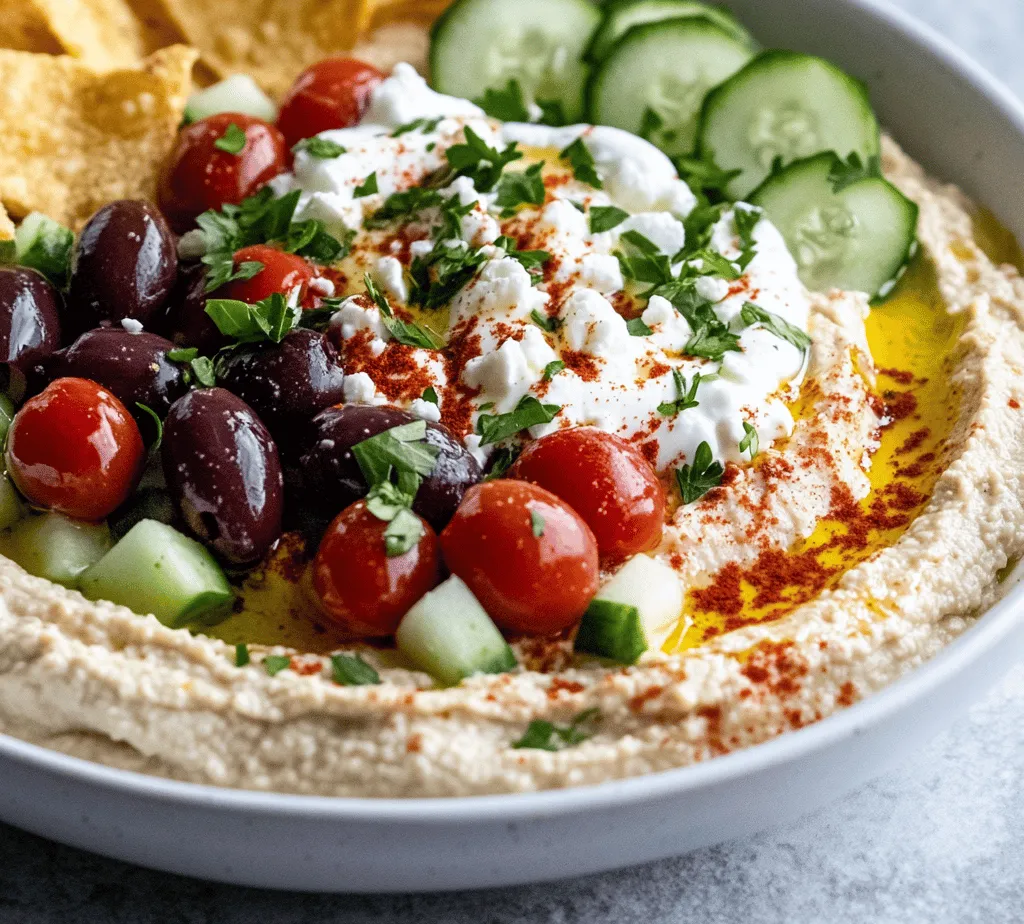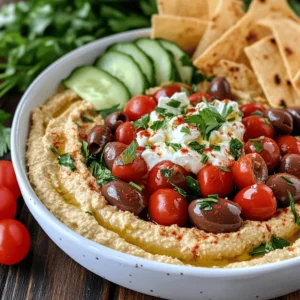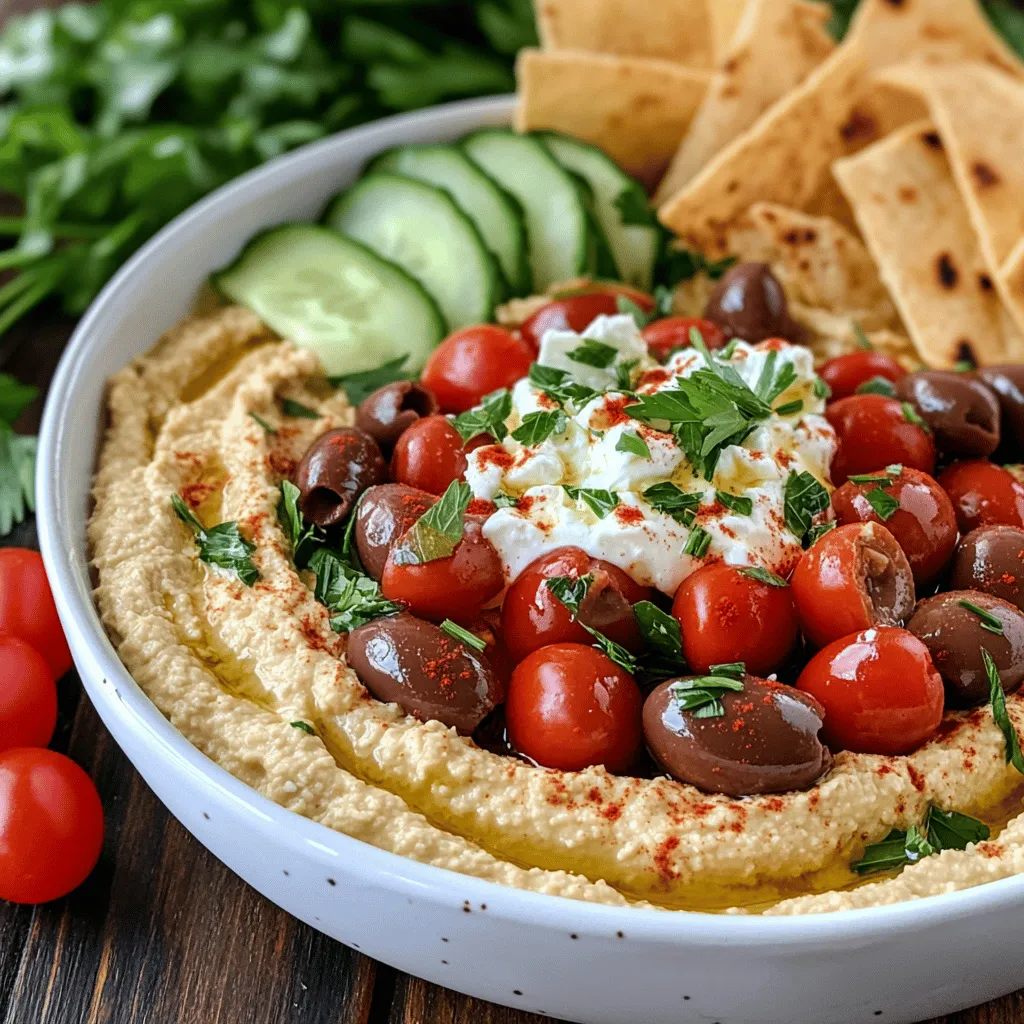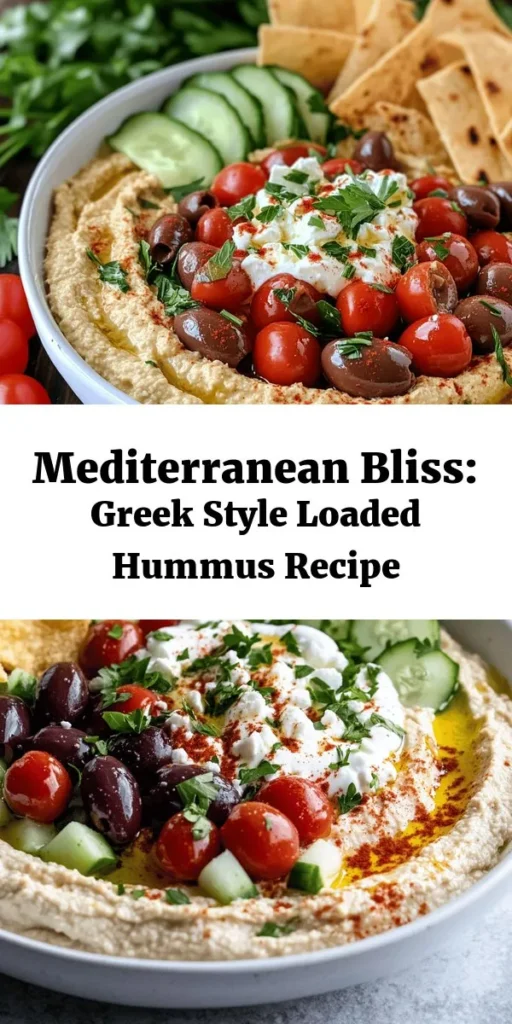Introduction
Greek Style Loaded Hummus is not just a dish; it’s a celebration of flavors, colors, and textures that embodies the essence of Mediterranean cuisine. This popular dish is quickly becoming a favorite among health-conscious individuals and food lovers alike, serving as a delightful snack or appetizer that appeals to a wide range of palates. Its creamy base, made primarily with chickpeas and tahini, is both satisfying and nutritious, making it an ideal choice for anyone looking to enjoy a wholesome bite.
One of the standout features of Greek Style Loaded Hummus is its reliance on fresh, high-quality ingredients. The use of quality produce not only enhances the flavor profile but also ensures that each component contributes its unique nutritional benefits. Whether you are preparing it for a casual gathering or as a part of your weekly meal prep, this dish offers a versatile approach that caters to various dietary preferences, including vegan, vegetarian, and gluten-free options.
This recipe embraces the spirit of Mediterranean cuisine, showcasing how simple ingredients can come together to create something truly special. With its rich history and cultural significance, loaded hummus is more than just a dip; it represents a way of bringing people together, making it a perfect addition to any dining table.
The Rich History of Hummus
Hummus has its roots deeply embedded in the Mediterranean and Middle Eastern culinary traditions. While the exact origins of hummus are debated, it is widely believed to have originated in the Levant region, which includes modern-day countries such as Lebanon, Syria, and Israel. The preparation of hummus dates back centuries, with references found in ancient texts that highlight its importance in the diet of the people from this region.
Throughout history, hummus has evolved, giving rise to numerous variations that reflect local ingredients and cultural influences. In the Mediterranean, hummus is often served as a meze, a selection of small dishes shared among diners, while in the Middle East, it is frequently paired with flatbreads and fresh vegetables. This adaptability has allowed hummus to transcend geographical boundaries, becoming a beloved dish worldwide.
As hummus gained popularity in the West during the late 20th century, it transformed from a niche ethnic food to a mainstream staple. Its rise can be attributed to the increasing awareness of healthy eating and plant-based diets, as well as the growing desire for flavorful and diverse food options. Today, hummus is enjoyed globally, with countless variations that incorporate different spices, herbs, and toppings, making it a versatile dish suitable for any occasion.
Understanding the Ingredients
To create a truly authentic Greek Style Loaded Hummus, it’s essential to understand the key ingredients that contribute to its flavor, texture, and nutritional profile. Each component plays a vital role in elevating the dish from a simple dip to a loaded, satisfying meal.
Chickpeas
Chickpeas, also known as garbanzo beans, form the base of hummus and are renowned for their nutritional benefits. Rich in protein, fiber, and essential vitamins and minerals, chickpeas are an excellent choice for anyone looking to maintain a balanced diet. They provide a creamy texture when blended, making them the perfect foundation for hummus. Additionally, the high fiber content in chickpeas promotes digestive health and helps to keep you feeling full for longer.
Tahini
Tahini, a paste made from ground sesame seeds, is an indispensable ingredient in hummus. It adds creaminess and depth of flavor, creating a rich and satisfying texture. Beyond its culinary benefits, tahini is also packed with nutrients, including healthy fats, protein, and calcium. Its nutty flavor complements the earthiness of the chickpeas, rounding out the overall taste of the dish. When selecting tahini, opt for high-quality, natural varieties that contain no added oils or preservatives.
Fresh Lemon Juice
The addition of fresh lemon juice is crucial in balancing the flavors of hummus. The acidity of lemon juice cuts through the richness of the tahini and adds a bright, zesty note that elevates the dish. Moreover, lemon juice is a great source of vitamin C and antioxidants, contributing to the overall health benefits of the recipe. Freshly squeezed lemon juice is preferred, as it provides a more vibrant flavor compared to bottled alternatives.
Garlic
Garlic is another essential ingredient that adds depth and character to Greek Style Loaded Hummus. Its robust flavor enhances the overall taste, while also offering numerous health benefits, including anti-inflammatory properties and boosting the immune system. When incorporating garlic, you can adjust the amount based on your preference for intensity; roasted garlic can be used for a milder flavor, while raw garlic provides a sharper taste.
Olive Oil
A drizzle of high-quality extra virgin olive oil is the finishing touch that brings everything together in hummus. Known for its health benefits, including heart-healthy monounsaturated fats and antioxidants, olive oil not only enhances the flavor but also contributes to a silky-smooth texture. When selecting olive oil, look for cold-pressed varieties to ensure the best quality and flavor. The rich, fruity notes of olive oil pair perfectly with the other ingredients, making it an essential component of this dish.
Overview of Topping Ingredients
While the base of Greek Style Loaded Hummus is delicious on its own, the toppings are what truly elevate this dish to the next level. Fresh, vibrant toppings add color, flavor, and texture, making the hummus not only more appealing but also more nutritious.
Greek Yogurt
Adding a dollop of Greek yogurt on top of the hummus provides an extra layer of creaminess and protein. Greek yogurt is known for its thick texture and tangy flavor, making it a perfect complement to the hummus. Additionally, it is rich in probiotics, which are beneficial for gut health, making this dish a wholesome option for your snacking needs.
Vegetables (Cucumber, Cherry Tomatoes)
Fresh vegetables such as cucumber and cherry tomatoes add a refreshing crunch and vibrant color to the hummus. Cucumbers are hydrating and low in calories, making them an ideal topping, while cherry tomatoes provide a burst of sweetness. Together, they enhance the overall flavor and nutritional profile of the dish, making it a well-rounded option for any meal.
Kalamata Olives and Feta Cheese
To add traditional Greek flavors, Kalamata olives and feta cheese are often included as toppings. Kalamata olives provide a briny, savory element that contrasts beautifully with the creamy hummus, while feta cheese adds a salty richness. Both ingredients are staples in Greek cuisine and contribute to the authentic taste of the dish.
Fresh Parsley and Smoked Paprika
Garnishing the hummus with fresh parsley and a sprinkle of smoked paprika not only enhances the presentation but also adds layers of flavor. Fresh parsley brings a burst of freshness, while smoked paprika introduces a subtle smokiness that elevates the dish. Together, they create a visually appealing and delicious topping that is sure to impress.
Step-by-Step Preparation Process
Now that we’ve explored the ingredients and their significance, it’s time to dive into the preparation process. Making Greek Style Loaded Hummus is straightforward and can be accomplished in just a few simple steps.
1. Prepare the Chickpeas: If using dried chickpeas, soak them overnight and cook them until tender. Alternatively, you can use canned chickpeas for convenience. Be sure to rinse and drain them before use to remove excess sodium.
2. Blend the Base Ingredients: In a food processor, combine the chickpeas, tahini, fresh lemon juice, garlic, and a drizzle of olive oil. Blend until smooth, scraping down the sides as needed. The consistency should be creamy and spreadable. If it’s too thick, add a little water or additional olive oil to achieve your desired texture.
3. Taste and Adjust: Once blended, taste the hummus and adjust the seasoning as needed. You can add more lemon juice for acidity, garlic for flavor, or tahini for creaminess.
4. Transfer and Top: Spoon the hummus into a serving dish, creating a small well in the center. Drizzle with extra virgin olive oil and top with your choice of toppings, including Greek yogurt, diced cucumber, halved cherry tomatoes, Kalamata olives, crumbled feta cheese, fresh parsley, and a sprinkle of smoked paprika.
5. Serve and Enjoy: Serve your Greek Style Loaded Hummus with pita bread, crackers, or fresh vegetables for dipping.
With these steps, you can create a delicious Greek Style Loaded Hummus that is sure to impress your family and friends. Stay tuned for more tips and tricks to perfect this dish in the following sections.

Preparation Overview and Time Commitment
Creating Greek Style Loaded Hummus is a delightful culinary journey that combines rich flavors and nutritious ingredients. This recipe is not only straightforward but also allows you to embrace the Mediterranean diet in the comfort of your own kitchen. The total time commitment for this dish is approximately 30 minutes, making it a perfect choice for a quick appetizer or a snack.
Preparation Time: 10 minutes
Cooking Time: 20 minutes
Total Time: 30 minutes
This timeframe includes the preparation of the hummus base as well as the toppings, ensuring that you can serve this dish fresh and vibrant for any gathering or meal.
Detailed Instructions for Making the Hummus
1. Gather the Ingredients: Start by assembling all your ingredients. You will need 1 can of chickpeas (drained and rinsed), ¼ cup of tahini, 2 tablespoons of olive oil, the juice of one lemon, 1-2 cloves of garlic (to taste), ½ teaspoon of ground cumin, and salt to taste.
2. Blend the Chickpeas: In a food processor, add the drained chickpeas and tahini. Blend them together until they form a coarse mixture, scraping down the sides as needed.
3. Add Flavorings: Next, add the olive oil, lemon juice, garlic, cumin, and a pinch of salt. Blend again until the mixture is well combined.
4. Incorporate Water: To achieve your desired consistency, slowly add cold water (start with 2 tablespoons) while blending. Continue to add water, a tablespoon at a time, until the hummus is smooth and creamy.
Instructions to Achieve the Perfect Creamy Texture
Achieving a creamy texture is key to a delicious hummus. Here are some essential tips:
– Use Ice-Cold Water: Adding cold water helps to emulsify the ingredients better, making the hummus lighter and creamier.
– Longer Blending Time: Don’t rush the blending process. Aim for a consistent blend of 2-3 minutes. This allows air to incorporate into the mixture, giving it a fluffy texture.
– Peel the Chickpeas: For an ultra-smooth hummus, consider peeling the chickpeas before blending. This can be time-consuming but will yield a creamier result.
Tips for Adjusting Seasoning During the Blending Process
As you blend your hummus, it’s crucial to taste and adjust the seasonings. Here’s how to do it effectively:
– Taste as You Go: After blending the initial mixture, taste the hummus. If it lacks flavor, consider adding more lemon juice, garlic, or salt. Start with small increments to avoid overwhelming the flavor.
– Balance Flavors: If your hummus tastes too tangy, a pinch of sugar or honey can help balance the acidity. Conversely, if it’s too rich, a bit more lemon juice will brighten it up.
Instructions for Preparing the Loaded Toppings
While your hummus is blending, you can prepare the toppings. The loaded toppings are what make this dish stand out, adding freshness and a delightful crunch.
1. Chop the Fresh Vegetables: For the toppings, gather cherry tomatoes, cucumbers, red onions, and bell peppers. Dice them into small, uniform pieces for an appealing presentation.
2. Prepare the Olives: Slice Kalamata olives in half and set them aside. Their briny flavor will enhance the overall taste of your dish.
3. Mix the Yogurt: In a small bowl, combine some Greek yogurt (or a vegan alternative) with a squeeze of lemon juice and a sprinkle of salt. This will add creaminess and a tangy flavor to your hummus.
Combining the Topping Ingredients for Freshness and Flavor
To create a cohesive topping that bursts with freshness, follow these steps:
1. Create a Topping Mixture: In a large bowl, combine the diced tomatoes, cucumbers, red onions, and bell peppers. Add the sliced olives, and toss everything together gently.
2. Season: Drizzle a little olive oil over the vegetable mixture, and season with salt and pepper to taste. You can also add chopped fresh herbs, such as parsley or mint, for an extra flavor boost.
Final Assembly: Layering the Toppings on Hummus for Visual Appeal
Now that your hummus and toppings are ready, it’s time for the final assembly.
1. Spread the Hummus: Using a spatula, spread the hummus onto a serving platter, creating a smooth and even layer.
2. Layer the Toppings: Carefully spoon the prepared vegetable topping mixture over the hummus, ensuring an even distribution.
3. Drizzle with Olive Oil: For added richness, drizzle a little extra olive oil over the top of the loaded hummus.
4. Garnish: Finish with a sprinkle of paprika or sumac for color and flavor, and top with a few fresh herb leaves for a pop of green.
Serving Suggestions
Greek Style Loaded Hummus is not only delicious but also versatile. Here are some ideas for serving and presenting this vibrant dish:
– Accompaniments: Serve your hummus with a side of warm pita bread or pita chips for dipping. Fresh vegetable sticks like carrots, celery, and bell peppers also pair beautifully.
– Presentation Tips: To impress your guests, serve the hummus in a shallow bowl, allowing the toppings to shine. Garnish with a drizzle of olive oil and a sprinkle of herbs before serving.
– Pairing with Mediterranean Dishes: This loaded hummus pairs wonderfully with other Mediterranean-inspired dishes such as falafel, tabbouleh, or grilled vegetables. Consider serving it as part of a mezze platter for a delightful spread.
Nutritional Benefits of Greek Style Loaded Hummus
Greek Style Loaded Hummus is not only a treat for the taste buds but also a nourishing option packed with health benefits.
– Chickpeas and Tahini: Chickpeas are an excellent source of plant-based protein, fiber, and essential vitamins and minerals. Tahini, made from ground sesame seeds, provides healthy fats, calcium, and antioxidants, making this hummus a nutrient-dense choice.
– Macronutrient Balance: This dish offers a balanced ratio of carbohydrates, proteins, and healthy fats, making it a satisfying and energizing snack or meal.
– Fresh Vegetables and Yogurt: The addition of fresh vegetables boosts the vitamin and mineral content, while yogurt contributes probiotics that support gut health.
Variations and Adaptations
This Greek Style Loaded Hummus is versatile and can be easily adapted to suit various dietary needs and preferences.
– Substitutions for Dietary Restrictions: If you’re avoiding chickpeas, consider using other legumes like white beans or lentils. For those with tahini allergies, sunflower seed butter or pumpkin seed butter can serve as alternatives.
– Vegan Alternatives: For a vegan version, substitute Greek yogurt with a plant-based yogurt made from coconut, almond, or soy.
– Low-Sodium or Reduced-Fat Preparations: To create a lower-sodium option, use low-sodium canned chickpeas and adjust the salt accordingly. For a reduced-fat version, use less olive oil and yogurt, or opt for a yogurt made from low-fat milk.
– Creative Flavor Additions: Feel free to experiment with spices and herbs. Adding smoked paprika, cumin, or even a dash of cayenne pepper can elevate the flavor. You can also mix in roasted red peppers or sun-dried tomatoes for a different twist.
Conclusion
Greek Style Loaded Hummus is a delightful and healthy choice that brings the flavors of the Mediterranean to your table. With its creamy texture and vibrant toppings, it’s perfect for any occasion, whether as a snack, appetizer, or part of a larger meal.
This recipe invites you to explore and make it your own. Don’t hesitate to experiment with different toppings, spices, or ingredient substitutes to suit your tastes. Enjoy the process of creating this delicious dish and indulge in the wonderful flavors of Mediterranean cuisine right at home.



